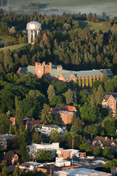War on Weeds — Weeds are Everybody’s Problem
Common Burdock
Common burdock (Arctium minus) is a biennial native to Europe that was accidentally introduced into the U.S. in the 1600’s. It invades roadsides, ditches, pastures, waste areas, forested areas and other sites (it prefers fertile, moist soil but can survive in a variety of conditions). Its Velcro-like seed heads attach easily to clothing and animals, allowing them to be transported great distances. Burs can be extremely difficult to remove when they become matted in wool and hair.
Common burdock has a unique appearance, growing up to 7 feet tall. After germination it forms large rosettes that bolt during the second year. Rosette leaves can be up to 18 inches long, are triangle shaped, with margins that are wavy or toothed. Upper leaves found on stems are smaller than rosette leaves. Flowers are purplish pink in color and are often found in clusters. Seed heads are typically 3/4 inches in diameter and have spiny bracts that act as Velcro, allowing them to stick to clothing, hair and wool. Common burdock is a prolific seed producer, a single plant can produce approximately 15,000 seeds.
Integrated Pest Management (IPM) options
- Prevention — Learn to identify this plant. Never transport unknown plant material. Make sure to inspect and remove burs from animals and clothing after leaving infested areas.
- Mechanical — Hand digging or pulling can be effective on small infestations, but common burdock has a stout taproot making it difficult. The whole root needs to be removed or plants may re-sprout. Tillage can effectively control seedlings. Mowing or cutting plants down before they produce seed can be an effective control strategy, but it may require multiple treatments.
- Cultural — Plant competitive beneficial vegetation. Use management practices that will benefit desirable vegetation.
- Chemical — There are several herbicide active ingredients available for use on common burdock. For more information visit https://pnwhandbooks.org/weed then search “burdock.” Always read and follow herbicide label directions.
Idaho is a wonderful place with awesome natural resources, landscapes, agriculture and recreational opportunities. Weeds threaten all the things that we love about Idaho. To detect, contain and control weeds in Idaho we have declared “War on Weeds.” These short articles are designed to give a brief description of each species, an explanation about why it’s a problem, insights into identification and Integrated Pest Management control options. — Justin Hatch
View or Download (pdf)
- Common burdock, 4-12
2024-2025 (pdf)
- Bur buttercup, 1-22
- Buckhorn plantain, 1-29
- Kochia, 2-5
- Feathered mosquito fern, 2-12
- Flowering rush, 2-17
- Jointed goatgrass, 2-24
- Giant hogweed, 3-2
- Hoary alyssum, 3-9
- Hydrilla, 3-16
- Giant knotweed, 3-23
- Johnsongrass, 3-30
- Quackgrass toms, 4-6
- Meadow hawkweed, 4-13
- Meadow knapweed, 4-20
- Mediterranean sage, 4-29
- Milium, 5-6
- Orange hawkweed, 5-11
- Parrotfeather milfoil, 5-24
- Perennial pepperweed, 6-1
- Dryer's woad, 6-8
- Purple starthistle, 6-29
- Saltcedar, 7-6
- Black Henbane, 7-24
- Scotch Broom, 8-3
- Squarrose knapweed, 8-10
- Syrian beancaper, 8-17
- Tall hawkweed, 10-5
- Water chestnut, 10-12
- Russian thistle, 10-19
- Musk thistle, 10-26
- Water hyacinth, 11-2
- Yellow devil hawkweed, 11-9
- Yellow flag iris, 11-16
- Eurasian watermilfoil, 11-23
- Yellow floating heart, 11-30
- Yellow starthistle, 12-7
- Phragmites, 12-14
- Common frogbit, 12-28
- Bittersweet nightshade, 1-4-25
- Diffuse knapweed, 1-11
- Russian knapweed, 2-12
- Spotted knapweed, 2-22
- Scotch thistle, 3-8
- White bryony, 3-15
- Canada thistle, 3-22
- Western salsify, 3-29
- Leafy spurge, 4-5
- Common burdock, 4-12
Photo courtesy of Catherine Herms, The Ohio State University, Bugwood.org.






